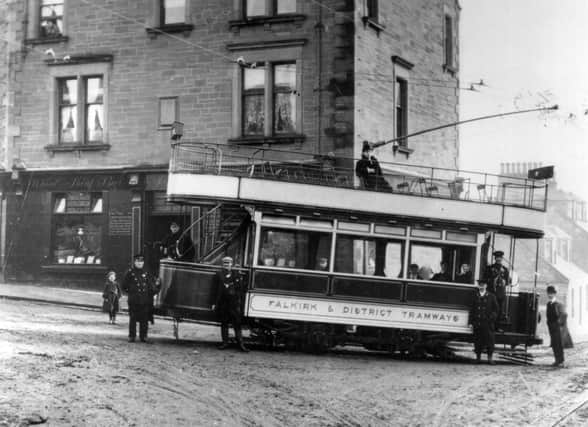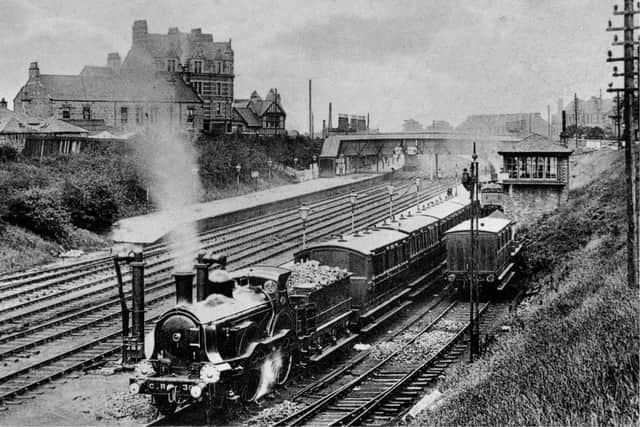Old Falkirk district tramway: A walk through the ‘Constantinople of the Scottish railways’


The great fluted column raised for ‘Old Joe’ Stainton and the ‘temple’ of William Dawson are surrounded by the tombs of many other members of their families.
Well worth a longer visit but we must press on.
Larbert Cross is still an important junction which once had an inn on each corner - the White Hart where the Commercial Hotel is, the Red Lion (now the Tea House), the Eagle Inn in front of the church and the Wheat Sheaf with a carved lion which used to be painted red.


Advertisement
Hide AdAdvertisement
Hide AdLeaving the cross and heading east along the main road we pass the former nurses’ home on the left and the primary school (1891) on the right.
The present Baptist Church is on the site of the original village school.
Across the road is Foundry Loan once the gateway to Larbert’s iron industry where hundreds toiled in Dobbie-Forbes, Jones and Campbell and Taylor’s.
When the cast iron trade declined the Larbert foundries were among the last survivors.
Advertisement
Hide AdAdvertisement
Hide AdOne reason for the location of the iron works was the arrival of the railway in 1848. Larbert became a major junction and one observer described the village as the ‘Constantinople of the Scottish Railways’.
The present Station Hotel with its Tudor style frontage opened around 1890.
A bit further on and we reach the point where Larbert ends and Stenhousemuir begins.
On the right stands the West Church opened in 1901 for the new United Free Church and since 1929 part of the Church of Scotland.
Advertisement
Hide AdAdvertisement
Hide AdThe Dobbie Hall (1901) designed by Alexander Black was the gift of iron master Robert Dobbie.
We follow the old tram route to the right along the Main Street, where the old Parish Office and Police Station stood until recent years, to the Plough Hotel once owned by Sir Michael Bruce of Stenhouse and still going strong after more than 150 years.
Back in the 1960s it was the port of call for us ‘bona fide’ travellers looking for a pint on a Sunday in days of yore!
Not far away was Stenhousemuir’s picture house, the Palace.
Just beyond the Plough we reach Gilmour’s Bar (1888) at the corner of Tryst Road.
Advertisement
Hide AdAdvertisement
Hide AdTo the left here we can spot the new B and M store once the site of McCowan’s sweetie factory and beyond it the Tryst ground home of the greatest cattle fairs in Europe for over a century until 1900.
Back to the walk and Larbert East Parish Church (1900) is on our left and, straight ahead, the site of the High School opened in 1886 as Larbert Central.
It is now covered in new flats.
The new school is further round to the right.
The area around here is called ‘Goshen’ after the biblical land of plenty presumably because wealthy folk from Carron had their houses here.
Stenhouse Road winds around the huge reservoirs completed in 1775 which once powered the iron works.
Advertisement
Hide AdAdvertisement
Hide AdToday the area is a nature reserve where one can see wild creatures including the two legged variety!
Not far away is what remains of the ironworks and the end of this second leg of the walk.
Next week we head up the hill back to Falkirk but meantime the ‘Soo Hoose’ beckons.
Message from the editor:
Thank you for reading this article on our free-to-read website. We're more reliant on your support than ever as the shift in consumer habits brought about by Coronavirus impacts our advertisers.
Please consider purchasing a subscription to our print newspaper to help fund our trusted, fact-checked journalism.
Comment Guidelines
National World encourages reader discussion on our stories. User feedback, insights and back-and-forth exchanges add a rich layer of context to reporting. Please review our Community Guidelines before commenting.
